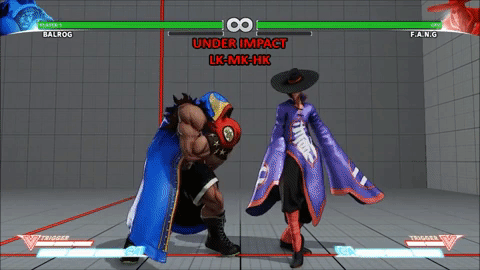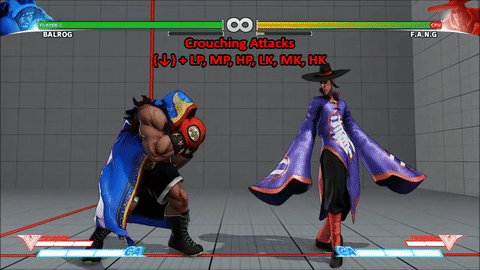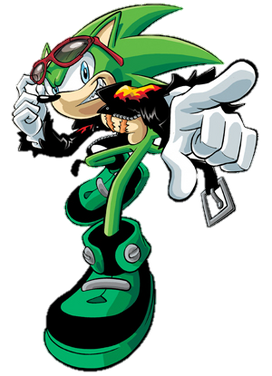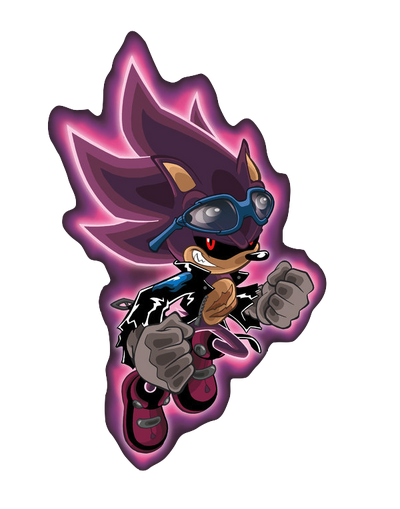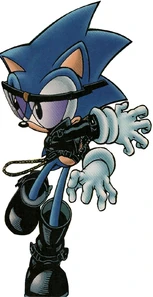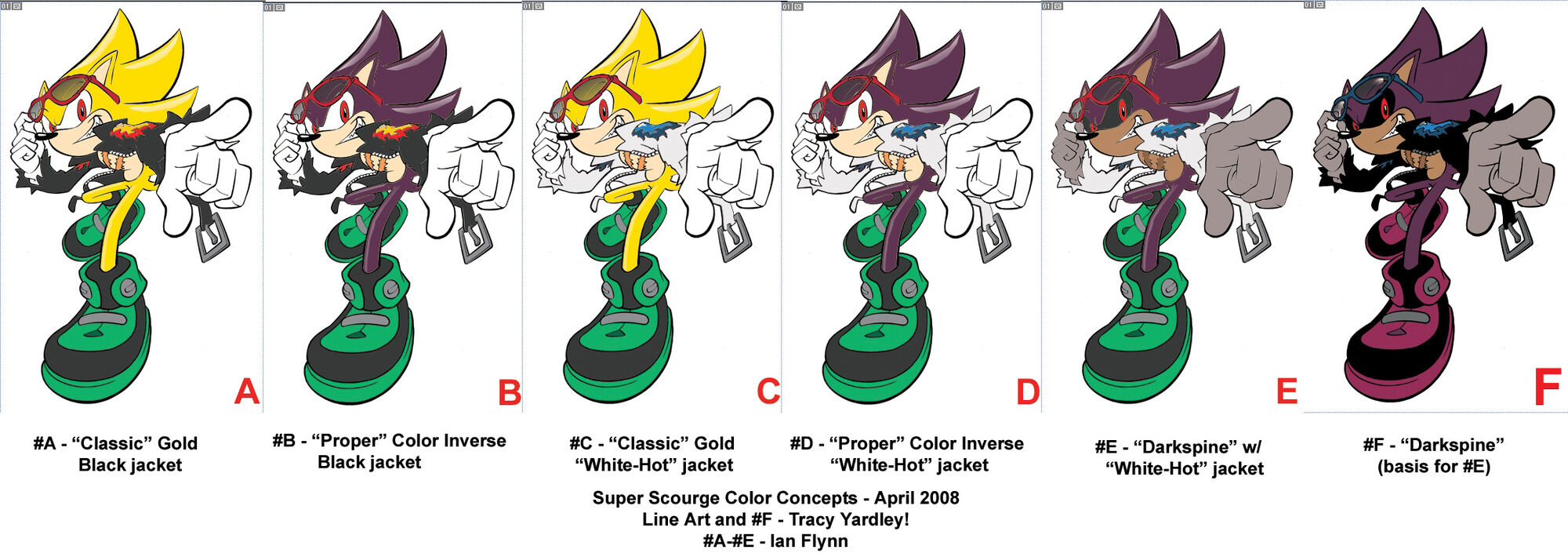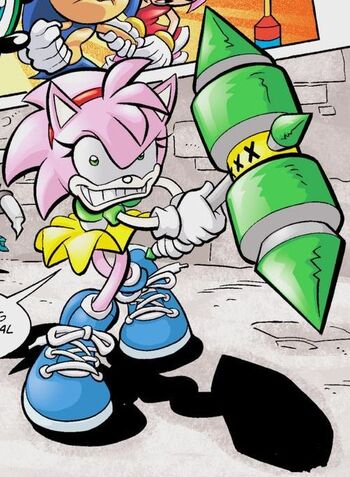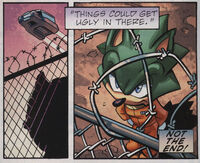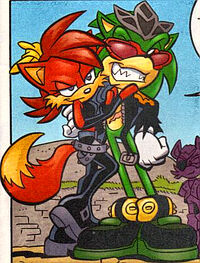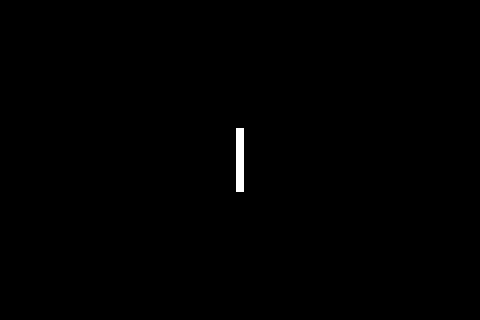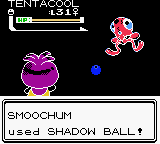Professor Lexicovermis
Smash Journeyman
"Ohohoho! What eeevil scheme will I use this time...?"

Scrambled Stats:Size: 10
Weight: 7
Ground Speed: 4
Jump: 10
Air Speed: 3
Fall Speed: 3
Traction: 2
Dr. Eggman, as always, pilots his iconic Eggomatic hovercraft into battle. This gives him a meaty hurtbox, impressive jump height, and floaty air movement, but limits his ground speed and traction. Additionally, his weight is rather low for his size due to constantly hovering.
Since this Eggman is specifically from Sonic Mania, he has a nasty trick up his sleeve in the form of the enigmatic Phantom Ruby. This ruby sits on the "dashboard" of the Eggomatic, and it glows visibly when in use. The Ruby allows Eggman to manipulate time and space to some degree, an ability he uses to bring his best inventions from the past into the present. All of Eggman's attacks involve either summoning one of his creations with the Ruby or utilizing the Eggomatic's myriad features.
A unique aspect of Eggman is the ability to Ruby Chain. By simply inputting another summon during a summon's animation, Ruby Chaining allows Eggman to use multiple summoning moves in a row with drastically reduced lag in between. However, this comes at the cost of slightly increased end lag when he stops; each subsequent summon after the second adds to this lag. There is no limit on how long a Ruby Chain can be, but Eggman cannot use the same summon twice in one Chain.
Neutral Special: Heavy Gunner
With a tap of B, Eggman chuckles heartily as the Phantom Ruby glows brilliantly. After a short bit of startup, Heavy Gunner, one of Eggman's elite Hard Boiled Heavies, appears in a temporary spacial distortion. Gunner, and the other Heavies by extension, stands as wide as Wario and as tall as Bowser. When summoned, Gunner immediately flies into the background, then brandishes a comically large rocket launcher. He then begins visibly aiming it at the nearest foe, following their movements with very little delay. After roughly half a second, Gunner fires off three rockets at his target. Two of these rockets are long, red missiles that fly at Sonic's dash speed. These Red Rockets have unlimited range, but detonate upon hitting any solid object. Additionally, they have no homing capabilities. Red Rockets deal 8% and KO at 185%, making them a somewhat threatening projectile. However, the third rocket in Gunner's clip is a bulbous, somewhat rickety blue missile. This Blue Rocket moves at Dr. Mario's awkward dash speed, and wobbles in a sort of sine wave pattern. Despite it's slow movement, the Blue Rocket is deceptively powerful, dealing 12% and killing as early as 160%. This Blue Rocket is a major risk/reward for Eggman; if an opponent attacks this Rocket, it will be redirected towards him and sped up considerably, reaching Sonic's dash speed. Eggman cannot deflect this sped up Rocket, and so must react quickly to dodge it. The deflected Rocket can hit characters other than Eggman, but they would have to be between him and the deflector. In a 2v2 scenario with friendly fire, Eggman could very well have his partner deflect Blue Rockets as a valid tactic. Once his clip is fired, Gunner vanishes into the same distortion he emerged from.
Side Special: Heavy Rider
With the same summoning animation as before, Eggman calls in Heavy Rider, another Hard Boiled Heavy. Unlike Gunner, she appears on the main battlefield directly in front of Eggman. Once she appears, she quickly dashes forwards on her trusty Motobug, swinging a large mace over her head. Rider moves rather quickly, crossing the stage as fast as Wario's bike. While she dashes, Rider leaves a trail of flames behind her, each flame a Kirby apart. These patches of fire deal rapid damage to anyone standing in them or lying prone in them; including Eggman. Meanwhile, Rider's mace deals a nasty 9% and knocks victims into prone. Rider has one more hitbox as well: the Motobug's tire. Hitting a foe with the tire deals no damage, but launches them with the force of the Bumper item. However, this is unreliable given that most foes will be clocked with the mace before the tire can hit. Rider dashes forward until hitting the ledge, then performs a quick donut and vanishes. If summoned in the air, Rider performs flashy stunts on her Motobug until she lands, dropping fire and swinging her mace as she falls to the ground.
Grounded Up Special: Heavy Magician
Eggman has two unique Up Specials, one being a summon and the other his recovery. Upon inputting this move on the ground, Eggman summons Heavy Magician, who appears slightly above and ahead of Eggman. She tips her hat to the foe before transforming in a puff of smoke. What she transforms into is influenced by which Heavy was summoned last.
If Gunner was previous, she becomes Nack the Weasel, infamous gunman. As Nack, Magician bounds across the stage on Nack's springy tail, flying a Kirby into the air and firing 2 Pokeball-sized corks every other bounce. These corks deal 6% and a surprisingly long flinch. Being bounced on by Nack Magician, however, deals 10% and causes burying. Magician is an intelligent minion and tries to stun foes before bouncing on them. Nack Magician cannot move without bouncing, meaning quick foes can run right under her.
If Rider was the last Heavy summoned, Magician becomes Bean the Dynamite, crazed demolitions expert. As Bean, Magician throws bombs at the opponent, aiming their arcing trajectories at the nearest foe. These bombs are identical to Link's, damage, knockback, and all. After throwing two bombs, Bean Magician leaps to another location, with no limit on how far she jumps.
If Shinobi was the last Heavy summon, Magician becomes Bark the Polar Bear, stoic strongman. As Bark, Magician slowly moves across the stage, occasionally pounding the floor with her fists. The seismic activity caused by these punches causes large chunks of debris to fall from the top blastzone, with the debris seeming to target foes. These chunks of debris deal 9% and a lengthy stun. If a foe gets close to Bark Magician, she will attempt to pound them into the ground, dealing 12% and burying her victim. As Bark, Magician has a painfully low jump, making her close range pound easy to avoid.
Magician is unique amongst the Heavies in that she persists until forced to leave by attacks. When hit with an attack that deals 6% or more damage, Magician is knocked out of her transformation and stunned for a moment, allowing opponents to deplete her 30 hp. Once depleted, she immediately vanishes into a spatial distortion, requiring 10 seconds to cooldown before she can be summoned again. Attempting to summon Magician before her cooldown ends will cause her hat to appear and dump a large Caterkiller in front of Eggman. The Caterkiller is a rather weak projectile that behaves similarly to a Gordo, bouncing across the stage with some obedience to gravity. The Caterkiller deals 6% and very negligible knockback, but summoning it is allowed in a Ruby Chain. A magical aura will appear around Eggman once Magician's cooldown ends.
Down Special: Heavy Shinobi
By far the fastest of Eggman's summons, boasting very little startup even outside a Ruby Chain, this move summons Heavy Shinobi. When summoned, Shinobi stands directly in front of Eggman in a defensive stance. If an opponent gets within a Bowser length of him, he performs an instantaneous slash with his icy katana, freezing the opponent in an immobile block of ice. Unlike the traditional Smash Freeze, the foe is not launched, and is instead left wide open for a moment. Frozen characters take 1.5 times the usual damage, but no knockback, as any attack shatters the ice block. Additionally, the frozen fighter can break the ice block themselves by button mashing. Shinobi's icy slash deals no damage, but its speed and freezing ability make it invaluable.
If nobody enters his range for a half second, Shinobi performs a high somersaulting jump. At the peak of this jump, Shinobi throws three Asters below him at differing angles, attempting to hit any foes beneath him. These Asters explode on contact with a foe, dealing 7% and killing around 180%. Should they hit the floor or a wall, the Asters stick in place, eventually exploding and launching small fireballs in each compass direction. These fireballs deal 5% and light knockback. If possible, Shinobi avoids hitting ice blocks with his Asters, allowing Eggman to use more powerful attacks on them instead.
Shinobi stays on stage for 7 seconds or until he is attacked once. Normally, he parries any attack with his katana, but he can be stunned by attacking him while he jumps. Once stunned, he only needs to be hit once more to remove him from the stage. Like Magician, Shinobi suffers cooldown after being defeated, though his is only 5 seconds. Inputting this move while Shinobi is on cooldown simply launches an Aster forwards. An icy aura surrounds Eggman for a moment when Shinobi can be summoned again.
F-Smash: Mini-Silver Sonic
Eggman's Smash attacks serve as summons too; they have similar lag to traditional Smash attacks and charging them changes the properties of the summoned minion. To help protect Eggman, they each have a traditional attack hitbox as well.
F-Smash causes Eggman to summon a Mini-Silver Sonic. These tiny terrors stand as tall as a Pikmin, though they are as wide as a Pokeball. Depending on the charge time, Mini-Silver Sonics perform one of two attacks:
When the summon is not charged, the Mini-Silver Sonic performs a short ranged "slap" of sorts. This slap is deceptively dangerous because it ignores Super Armor. Don’t get too excited, though: it deals a paltry 4% and flinching. After this slap, the MSS quickly rushes across the stage at Sonic's dash speed. This dash deals 8% and kills at 185%. The MSS explodes into harmless junk after colliding with a foe. The MSS can and will merrily dash off ledges to their doom.
The MSS is summoned as soon as the move is input, and begins charging a spin dash if the Smash is charged. Once the charge is released, the MSS immediately launches across the stage in a spin dash comparable to Sonic's Down Special. The longer the Smash is charged, the faster the MSS goes, capping at a speed slightly faster than Sonic's dash. This spin dash deals 7-13% and kills at 170-155%. Upon hitting a foe or solid object, the MSS ricochets off at a 45 degree angle, retaining its speed and damage. If it hits another object, it ricochets once again. An MSS can ricochet an unlimited amount of times, but in practice is unlikely to hit more than two objects before launching off the nearest blastzone. Take care, as Eggman can be hit and even killed by an MSS in flight.
Two MSS units can be in play at a time; using this Smash while two are out unceremoniously destroys the oldest one. This summon is rather useful in a Ruby Chain, with the Armor-busting slap coming in handy for things like Focus Attack and the like. Since MSS's attack is nearly instant upon releasing the charge, this is the only Smash that lacks a hitbox on Eggman's person.
U-Smash: Mean Bean Machine
Possibly the strangest of Eggman's summons, the U-Smash summons a Puyo, err, "Mean Bean". Upon inputting the move, a Mean Bean appears above Eggman, changing color as the Smash is charged. Each color has different properties when released. The color cycle goes Yellow-Green-Blue-Purple-Red.
Yellow Beans explode in a gooey blast directly over Eggman's head. This is a fairly simple U-Smash comparable in reach and utility to Link's U-Smash. The Yellow Bean deals 9% and kills at 185%.
Green Beans work similarly to Snake's mortar U-Smash from Brawl, launching upwards and falling in front of Eggman. Again, fairly straightforward Smash. Green Beans deal 10% and kill at 180%.
Blue Beans are where the move begins getting more interesting. Blue Beans drop down directly ahead of Eggman, creating a nasty caustic puddle. This puddle will temporarily trap opponents and deal extremely rapid damage to them until they escape by button mashing. The puddle lasts for 4 seconds or until someone gets stuck in it. Hitting with the Bean itself deals 12% and knocks the opponent into prone, possibly even causing them to land in the puddle created by the Bean.
Purple Beans take inspiration from the infamous purple Mega Mack that floods Chemical Plant Zone. They are launched in a similar manner to Green Beans, with one difference: they latch onto their victim's head in an attempt to suffocate them. Opponents with a Purple Bean on their head suffer greatly inhibited movement and jumping, but are in far greater danger than that. Once the Bean latches on, a 5-second timer appears above the victim. Should it deplete, they fall into prone and suffer a horrific 18%. Thankfully, shrugging off a Bean is as simple as button mashing as though escaping a grab. Having Heavy Shinobi freeze a suffocating foe is a valid, if extremely cruel tactic; most foes will likely be aware of this combo, however, and do all in their power to avoid it.
Finally, Red Beans explode into a shower of clear Garbage Beans. These Garbage Beans fly all around Eggman, somewhat like the shrapnel from Charizard's Rock Smash. One flies straight up, and three fly off on each side, one in a high arc, one straight outwards, and the other in a shallow arc. Each of the 7 Garbage Beans deals 7% and sticks the foe in place, likely guaranteeing at least one more hit. Best case scenario, the foe ends up with 21% from the Garbage alone. The Red Bean's explosion itself deals 16% and kills at 155%, but its hitbox is rather small and located directly above Eggman.
Mean Bean Machine is a versatile summon and, thanks to the reduced startup, is especially useful to end a Ruby Chain. Use Yellow Bean for a quick U-Smash, Green to hit someone above you, Blue to make a nasty trap, Purple in combination with Shinobi for a terrifying stranglehold, or Red to rain chaos on the stage.
On top of the summon, Eggman strikes a dramatic pose, raising the Ruby high into the air. This pose acts as a traditional, if somewhat weak U-Smash hitbox, dealing 5-9% and killing at 190-175%.
D-Smash: Gachapandora
Originally a feature of the Eggomatic, the Gachapandora line of Badniks are toy-sized robots based on older models of Eggman's Eggomatic. The D-Smash, when input, summons a Gachapon capsule the size of a party ball over Eggman's head. Depending on the charge, one of four Gachapandora Badniks will emerge. When the contents of the capsule change, it shakes visibly to let Eggman know. To protect Eggman, each capsule drops to his "feet" and bursts open violently, acting as a traditional D-Smash that deals 10-16% and kills at 185-170%.
With no charge, the capsule contains a Pokeball sized Eggomatic complete with authentic, also Pokeball-sized wrecking ball attachment. This Sonic 1 Gachapandora behaves identically to the boss fight on which it is based; it flies back and forth across the stage at Mario's dash speed, swinging its wrecking ball. Contact with this wrecking ball deals 8% and light knockback. This is essentially a toy, after all. The Sonic 1 Gachapandora is a garden variety pest, being a nice supplement to your damage output and little else. The Gachapandora has 15 hp.
With a short charge, the capsule reveals a Drillmobile Gachapandora the size of a Pikmin lying on its side. This particular Gachapandora is based, of course, on the first boss from Sonic 2, and behaves as such. The Sonic 2 Gachapandora drives around at Luigi's dash speed, attempting to skewer opponents with its drill. This drill deals a surprising 10% and kills at 175%. The deceptive power of the Sonic 2 Gachapandora makes it a reliable minion, but it has a crippling weakness in that it cannot jump. At the very least, it turns automatically at ledges. This Gachapandora has 25 hp, and launches its drill as a desperation move when it is destroyed.
Further charge time will cause the capsule to create a rather large (Soccer Ball-sized) model of the Egg Flamecraft from Sonic 3's Angel Island. This is the largest Gachapandora, and one of the more complex mechanically. The Flamecraft follows a very rigid pattern: fly forward one Battlefield platform length, fire off a flame downwards, fire off a flame down at a 45 degree angle, turn if a foe is behind it, repeat. The only real wrinkle is the fact that the Flamecraft flies into the background when relocating, rendering it invulnerable until it attacks. The flames shot by this Gachapandora deal 12% and kill at 170%; they also crawl along the ground a very short ways should they miss, allowing the Gachapandora a little leeway. This particular Gachapandora has only 10 hp, but its extensive periods of invincibility render it surprisingly durable.
Finally, a full charge unleashes a truly terrifying Gachapandora: an Amy Doll. These Pikachu-sized automatons are deceptively dangerous, and yet one of the simplest minions at Eggman's disposal. The Amy Doll, upon being summoned, charges forward recklessly, relentlessly pursuing the nearest opponent it can find. Once it catches them, it grabs onto them with a robotic laugh. After one second, the Doll violently explodes, dealing a hideous 17% and killing as early as 145%. The Amy Doll's plush body renders it effectively invulnerable, but it is still susceptible to knockback. In fact, knocking it into Eggman will cause it to grab him! Thankfully, the Amy Doll can be transferred like a Sticky Bomb, but act fast.
The Gachapandora summons make for a very unorthodox D-Smash, but they are an undeniable boon to Eggman's offense. Up to two of each model can exist at a time, but your opponents would be mad to let you form such an army. Gachapandora is very helpful in the middle of a Ruby Chain, especially the quicker summons such as the S1 or S2 minions.
N-Air: Shutterbug / Ruby Shock
Eggman's last few summons are aerial moves. To use an aerial in a Ruby Chain, Eggman simply uses the A button and the desired direction, being careful NOT to smash the input. Each of these lesser summons calls in a Badnik that debuted in Mania.
The N-Air summons a Shutterbug. These paparazzi pests float around quickly, following opponents and attempting to take photos of them. The Shutterbugs' camera flashes temporarily stun any character that is both facing them and within a Battlefield Platform of them. Additionally, the flash deals an irritating 4%. Shutterbugs are bog standard stunning minions, designed purely to aggravate. However, their stun can prove useful sometimes. 2 Shutterbugs can exist at a time, and they have a paltry 10 hp.
In addition to the summon, each Aerial also has a more standard hitbox. In this case, a large blast of Ruby energy envelopes the Eggomatic for an attack identical to Mewtwo's N-Air.
F-Air: Orbinaut / Percussive Maintenance
Eggman summons an Orbinaut; more specifically the bumper-based model used in Studiopolis. Orbinauts patrol back and forth forever, staying at the height they were created at. When an opponent gets within a Kirby of them, they begin rapidly spinning their bumpers around, making a nigh-impenetrable barrier that bounces fighters and projectiles away. Contacting this barrier launches the unlucky fighter just like a Bumper, and Eggman must take care not to touch his own minion's barrier! After a short period of spinning, the Orbinaut drops its barrier for a short while, allowing opponents to damage it. Orbinauts have 15 hp and only one can exist at a time.
Meanwhile, in a move inspired by Oil Ocean's new miniboss, Eggman swings a comically large wrench with a mechanical arm that extends from within the Eggomatic. This seems like a fairly generic F-Air, and for the most part it is. The wrench whack deals a sharp 10% and kills at 175%. However, the main purpose of this move is to perform maintenance on your summons. This move heals any summon with health for 7 hp, and has some unique effects on those without hp.
Hitting Heavy Shinobi while he somersaults will launch him forwards very quickly, with the robot quickly sprouting large blades on his person. This essentially makes Heavy Shinobi into a Bowser-sized shuriken that deals a painful 15% and kills at 150%. As a shuriken, Shinobi flies at Mario's dash speed and has infinite range. This is a wonderful finisher, but requires some setup and timing. Plus, if you miss, you've wasted a Shinobi summon and must wait for him to come off cooldown.
Hitting Heavy Rider will send her Motobug into a frenzy, doubling its speed and causing it to turn around at the ledge without vanishing. In addition, the flames it drops are now only a Pokeball apart, making Rider even more dangerous. A frenzied Rider will stick around for 5 seconds, longer than her usual "until I hit a ledge".
A Mini-Silver Sonic in flight can be hit, launching it down at a 45 degree angle. This is extremely risky and not recommended, but it is an option.
Hitting a Mean Bean, only possible with a Green or Blue Bean and impeccable timing, simply launches it forwards in a shallow arc, where it behaves normally.
Finally, hitting an Amy Doll will cause it to panic and run away from Eggman. Great if one is too close for comfort.
U-Air: Eagloid / Tentakill
This aerial summons a rather annoying flying Badnik first seen in Mirage Saloon. Eagloids fly around in wide, curving paths at Wario's dash speed. They seem to move around aimlessly, but actually manipulate their flight path intelligently in order to hit opponents. An Eagloid's ram deals 12% and kills at 180%. This isn't a very powerful minion, and they only have 10 hp. However, their speed and unpredictable flight pattern make them more durable than one might think. Two Eagloids can exist at a time.
While the Eagloid flies off, the Eggomatic launches a pink robotic tentacle tipped with a blade. This tentacle is launched from the Eggomatic's back end, arcs above Eggman's head, then lands in a receptacle that emerges from the front of the Eggomatic. This move is faster than described, taking about as much time as an average U-Air. The tentacle has a sweetspot on its blade, which can be rather difficult to land. The tentacle deals 9% and kills at 185%, while the blade deals 12% and kills at 175%. Other than the rather odd animation, this is a fairly straightforward aerial.
B-Air: Splats / Reanimator
This summon is a rather adorable Badnik that is an odd cross between a rabbit and a rubber stamp. Splats quickly fall to the ground, where they begin their hopping across the stage joyfully. As they hop, they leave small puddles of ink. These ink puddles dramatically slow anyone walking through them, but only last for 2 seconds. Splats can only do damage by landing on a fighter. This stomp attack deals 6% and stuns the victim. Splats will never leap off of a ledge, and their surprisingly high 20 hp makes them a solid minion. Up to three Splats can exist at a time.
While the Splats fall to the ground, a large device resembling a cross between an industrial magnet and a lamp emerges from the rear of the Eggomatic. This device then generates a large pulse of electricity behind the Eggomatic. This pulse deals rapid hits of 2% to anyone caught inside and places them in helpless. Much like the F-Air, this move has unique properties when used with Eggman's minions.
Using it on a "lesser" minion (the aerial Badniks) will cause said Badnik to be pulled towards Eggman, relocating them and healing them for 2 hp. This allows him to alter the height of Orbinauts, the path of Eagloids, and more while topping off their health.
Zapping Heavy Shinobi causes him to become much more aggressive; he stops attempting his icy parry and instead begins jumping constantly. He also begins throwing four Asters per jump instead of three. Pairs very well with the F-Air's ability to make a jumping Shinobi into a deadly projectile.
Zapping Heavy Rider causes her to jump extremely high, leaving a trail of flames behind her in the air. These flames deal rapid damage and fade away after a while, but can help control the battlefield.
Unlike the F-Air, this move can influence Heavy Gunner, or at least his rockets. Using it near one of his projectiles will cause it to spin around for a moment before targeting a new foe and launching off. This does NOT work on Blue rockets that have been deflected towards Eggman.
Likewise, this move effects Heavy Magician. Shocking her will cause her to change into the next disguise in her repertoire. The disguises cycle in the order Nack-Bean-Bark. This still heals her for 2%.
The electrical pulse has the same effect on all minions summoned by Smashes: it magnetically drags them to Eggman's back before releasing them. Adjust the height of Gachapandora Badniks, grab and release a ricocheting Mini-Silver Sonic, or somehow grab a nonmetallic Mean Bean.
D-Air: Ironsight / Excavate
Eggman's final summon is a rather interesting Badnik hailing from Titanic Monarch Zone. Ironsight ominously hovers around a small area near his summoning point. Once a foe enters a Bowser-sized area around him, a large wireframe "cage" appears around said foe. This cage slowly shrinks, becoming a crosshair and following the victim's every move. After 2 seconds, the Ironsight fires off an invisible, instantaneous shot that hits the targeted foe for a whopping 17% and drops them into prone. Ironsight is a very scary minion mainly due to his impeccable aim. However, there are a few ways to escape his vision: get a Final Destination away from him, dodge right as he takes the shot, equip a Cloaking Device, or simply destroy Ironsight. With his 35 hp, most characters have just enough time to destroy him before he can pop off a shot, but Eggman has ways to protect him. Only one Ironsight can exist at a time.
Once Ironsight is on patrol, the Eggomatic suddenly sprouts an array of drills on its underside before plummeting to the ground. Hitting an opponent will cause Eggman to bounce upwards, while the foe ends up spiked with 13% more damage, as per the traditional heavyweight D-Air. Hitting the ground, however, causes Eggman to rapidly drill into it, launching rocks and debris in a short area around him for a few moments. These rocks deal 2-4% damage and flinching. Hitting a shielding foe, however, causes Eggman to rapidly drill the shield, dealing extreme shield damage before he simply disengages the drills. All in all, a solid addition to Eggman's toolkit.
Aerial Up Special: Jet Boost
In a fairly standard recovery, Eggman activates the Eggomatic's auxiliary thrusters and quickly ascends skyward. This is a fairly decent recovery, covering decent vertical and horizontal distance but having no hitbox. Interestingly, this move's endlag ends just before Eggman stops ascending. This can potentially allow for some interesting summons…
Jab: Rocket Punch
For this Jab, a mechanical arm tipped with three drills launches forwards from the Eggomatic. This Jab is comparable in speed and reach to Ganondorf's, with Eggman's having slightly more range. The main advantage is being able to angle this Jab by pressing up or down during the brief startup. This move deals 6% and light knockback. Very simple, very reliable, very efficient. A somewhat odd property of this move is the fact that, while it's extended, the arm acts as a drop-through platform. This is little more than a novelty, but perhaps one could find a use for it; maybe giving low-jumping minions a boost…?
F-Tilt: Shredder
Taking inspiration from the Press Garden miniboss, the Eggomatic sprouts a Kirby-sized sawblade on a pole. This sawblade is awkwardly thrust forward in a rather laggy F-Tilt. The sawblade deals constant rapid hits of 2%, but barely any knockback. This move can be angled, but its primary strength is in its ability to combo into itself for reduced lag. By simply mashing A, the sawblade can be extended and retracted over and over; it can even be angled up or down in different directions each time! However, there is a weakness: if this Tilt deals too much shield damage, the blade shatters, leaving Eggman with increased endlag. Be sure to stop cutting if the foe puts their shield out.
U-Tilt: High Wind Advisory
In a move inspired by Studiopolis Zone's weather-themed boss, a comically large fan pops out of the Eggomatic. This fan then spins at absurd speeds, creating a visible updraft above Eggman. This updraft deals no damage, but the sheer speed of it rapidly pushes anything above Eggman towards the top of the screen. The updraft reaches roughly two Ganondorfs above Eggman, and can be held indefinitely. However, Eggman cannot move while holding this attack. Eggman's minions are also affected by this wind, making it useful for moving them about.
D-Tilt: Eggmine
From the now grounded Eggomatic, Eggman tosses a Soccer Ball-sized red mine bearing his likeness. This mine lands just ahead of him and stays there either until a foe gets within a character length or 7 seconds pass. Once one of these conditions is met, the mine violently explodes in a Kirby-sized blast. This blast deals a sharp 11% and kills as early as 165%. The mines can be manipulated with some of Eggman's moves, and will not trigger when bear him, but they can and will damage him once their timer ends. This is a useful trap, but take care not to blow yourself up! Up to three mines can exist per Eggman.
Dash Attack: Starlight
Using an attack from the Stardust Speedway miniboss, Eggman hovers upwards slightly while firing a large beam below him. All in all, he floats roughly a Ganondorf in the air and moves about a Battlefield platform before suffering severe endlag. This is surprisingly slow for a Dash Attack, but is rewarding to land; it deals 12% and kills at 165%.
Grab: BIG ARMS
Thanks to the sheer size of the mechanical arms used for this Grab, Eggman has the longest grab range in the game. However, missing it leaves him with the worst grab lag in the game as punishment. The dash grab is similar, but with slightly less range and lag. Eggman's Pummel has him simply squeeze his captive with the BIG ARMS. Very slow, but deals a nasty 9%. Don't expect to get more than a single pummel off, though.
F-Throw: Eggman releases his foe before unleashing a massive haymaker punch with the BIG ARMS. This punch deals 13% and sends the victim skidding across the stage in prone. This throw typically kills around 155%.
U-Throw: Still holding the foe, Eggman hovers upwards slightly before suddenly cutting the Eggomatic's engines, causing it to plummet to the ground. The foe is slammed down as well, taking a horrific 17% and becoming dizzy for a moment. Eggman suffers considerable lag after this throw, enough to prevent chaingrabs but short enough to allow another followup.
B-Throw: A large Bumper emerges from the rear of the Eggomatic as Eggman uses the BIG ARMS to slam the foe face first into said Bumper. This maneuver deals 9%, but can kill at 145%. Easily Eggman's best kill throw, but the weakest for damage racking.
D-Throw: Eggman releases the foe as he does in the F-Throw. This time, he uses the BIG ARMS to pound his victim into the ground, dealing 12% and pitfalling them. Just like the U-Throw, the lag on this throw is enough to prevent chaingrabs.
Sonic Mania Eggman

Scrambled Stats:
Weight: 7
Ground Speed: 4
Jump: 10
Air Speed: 3
Fall Speed: 3
Traction: 2
Dr. Eggman, as always, pilots his iconic Eggomatic hovercraft into battle. This gives him a meaty hurtbox, impressive jump height, and floaty air movement, but limits his ground speed and traction. Additionally, his weight is rather low for his size due to constantly hovering.
Since this Eggman is specifically from Sonic Mania, he has a nasty trick up his sleeve in the form of the enigmatic Phantom Ruby. This ruby sits on the "dashboard" of the Eggomatic, and it glows visibly when in use. The Ruby allows Eggman to manipulate time and space to some degree, an ability he uses to bring his best inventions from the past into the present. All of Eggman's attacks involve either summoning one of his creations with the Ruby or utilizing the Eggomatic's myriad features.
A unique aspect of Eggman is the ability to Ruby Chain. By simply inputting another summon during a summon's animation, Ruby Chaining allows Eggman to use multiple summoning moves in a row with drastically reduced lag in between. However, this comes at the cost of slightly increased end lag when he stops; each subsequent summon after the second adds to this lag. There is no limit on how long a Ruby Chain can be, but Eggman cannot use the same summon twice in one Chain.
Summons - Ruby Delusions
Neutral Special: Heavy Gunner
With a tap of B, Eggman chuckles heartily as the Phantom Ruby glows brilliantly. After a short bit of startup, Heavy Gunner, one of Eggman's elite Hard Boiled Heavies, appears in a temporary spacial distortion. Gunner, and the other Heavies by extension, stands as wide as Wario and as tall as Bowser. When summoned, Gunner immediately flies into the background, then brandishes a comically large rocket launcher. He then begins visibly aiming it at the nearest foe, following their movements with very little delay. After roughly half a second, Gunner fires off three rockets at his target. Two of these rockets are long, red missiles that fly at Sonic's dash speed. These Red Rockets have unlimited range, but detonate upon hitting any solid object. Additionally, they have no homing capabilities. Red Rockets deal 8% and KO at 185%, making them a somewhat threatening projectile. However, the third rocket in Gunner's clip is a bulbous, somewhat rickety blue missile. This Blue Rocket moves at Dr. Mario's awkward dash speed, and wobbles in a sort of sine wave pattern. Despite it's slow movement, the Blue Rocket is deceptively powerful, dealing 12% and killing as early as 160%. This Blue Rocket is a major risk/reward for Eggman; if an opponent attacks this Rocket, it will be redirected towards him and sped up considerably, reaching Sonic's dash speed. Eggman cannot deflect this sped up Rocket, and so must react quickly to dodge it. The deflected Rocket can hit characters other than Eggman, but they would have to be between him and the deflector. In a 2v2 scenario with friendly fire, Eggman could very well have his partner deflect Blue Rockets as a valid tactic. Once his clip is fired, Gunner vanishes into the same distortion he emerged from.
Side Special: Heavy Rider
With the same summoning animation as before, Eggman calls in Heavy Rider, another Hard Boiled Heavy. Unlike Gunner, she appears on the main battlefield directly in front of Eggman. Once she appears, she quickly dashes forwards on her trusty Motobug, swinging a large mace over her head. Rider moves rather quickly, crossing the stage as fast as Wario's bike. While she dashes, Rider leaves a trail of flames behind her, each flame a Kirby apart. These patches of fire deal rapid damage to anyone standing in them or lying prone in them; including Eggman. Meanwhile, Rider's mace deals a nasty 9% and knocks victims into prone. Rider has one more hitbox as well: the Motobug's tire. Hitting a foe with the tire deals no damage, but launches them with the force of the Bumper item. However, this is unreliable given that most foes will be clocked with the mace before the tire can hit. Rider dashes forward until hitting the ledge, then performs a quick donut and vanishes. If summoned in the air, Rider performs flashy stunts on her Motobug until she lands, dropping fire and swinging her mace as she falls to the ground.
Grounded Up Special: Heavy Magician
Eggman has two unique Up Specials, one being a summon and the other his recovery. Upon inputting this move on the ground, Eggman summons Heavy Magician, who appears slightly above and ahead of Eggman. She tips her hat to the foe before transforming in a puff of smoke. What she transforms into is influenced by which Heavy was summoned last.
If Gunner was previous, she becomes Nack the Weasel, infamous gunman. As Nack, Magician bounds across the stage on Nack's springy tail, flying a Kirby into the air and firing 2 Pokeball-sized corks every other bounce. These corks deal 6% and a surprisingly long flinch. Being bounced on by Nack Magician, however, deals 10% and causes burying. Magician is an intelligent minion and tries to stun foes before bouncing on them. Nack Magician cannot move without bouncing, meaning quick foes can run right under her.
If Rider was the last Heavy summoned, Magician becomes Bean the Dynamite, crazed demolitions expert. As Bean, Magician throws bombs at the opponent, aiming their arcing trajectories at the nearest foe. These bombs are identical to Link's, damage, knockback, and all. After throwing two bombs, Bean Magician leaps to another location, with no limit on how far she jumps.
If Shinobi was the last Heavy summon, Magician becomes Bark the Polar Bear, stoic strongman. As Bark, Magician slowly moves across the stage, occasionally pounding the floor with her fists. The seismic activity caused by these punches causes large chunks of debris to fall from the top blastzone, with the debris seeming to target foes. These chunks of debris deal 9% and a lengthy stun. If a foe gets close to Bark Magician, she will attempt to pound them into the ground, dealing 12% and burying her victim. As Bark, Magician has a painfully low jump, making her close range pound easy to avoid.
Magician is unique amongst the Heavies in that she persists until forced to leave by attacks. When hit with an attack that deals 6% or more damage, Magician is knocked out of her transformation and stunned for a moment, allowing opponents to deplete her 30 hp. Once depleted, she immediately vanishes into a spatial distortion, requiring 10 seconds to cooldown before she can be summoned again. Attempting to summon Magician before her cooldown ends will cause her hat to appear and dump a large Caterkiller in front of Eggman. The Caterkiller is a rather weak projectile that behaves similarly to a Gordo, bouncing across the stage with some obedience to gravity. The Caterkiller deals 6% and very negligible knockback, but summoning it is allowed in a Ruby Chain. A magical aura will appear around Eggman once Magician's cooldown ends.
Down Special: Heavy Shinobi
By far the fastest of Eggman's summons, boasting very little startup even outside a Ruby Chain, this move summons Heavy Shinobi. When summoned, Shinobi stands directly in front of Eggman in a defensive stance. If an opponent gets within a Bowser length of him, he performs an instantaneous slash with his icy katana, freezing the opponent in an immobile block of ice. Unlike the traditional Smash Freeze, the foe is not launched, and is instead left wide open for a moment. Frozen characters take 1.5 times the usual damage, but no knockback, as any attack shatters the ice block. Additionally, the frozen fighter can break the ice block themselves by button mashing. Shinobi's icy slash deals no damage, but its speed and freezing ability make it invaluable.
If nobody enters his range for a half second, Shinobi performs a high somersaulting jump. At the peak of this jump, Shinobi throws three Asters below him at differing angles, attempting to hit any foes beneath him. These Asters explode on contact with a foe, dealing 7% and killing around 180%. Should they hit the floor or a wall, the Asters stick in place, eventually exploding and launching small fireballs in each compass direction. These fireballs deal 5% and light knockback. If possible, Shinobi avoids hitting ice blocks with his Asters, allowing Eggman to use more powerful attacks on them instead.
Shinobi stays on stage for 7 seconds or until he is attacked once. Normally, he parries any attack with his katana, but he can be stunned by attacking him while he jumps. Once stunned, he only needs to be hit once more to remove him from the stage. Like Magician, Shinobi suffers cooldown after being defeated, though his is only 5 seconds. Inputting this move while Shinobi is on cooldown simply launches an Aster forwards. An icy aura surrounds Eggman for a moment when Shinobi can be summoned again.
F-Smash: Mini-Silver Sonic
Eggman's Smash attacks serve as summons too; they have similar lag to traditional Smash attacks and charging them changes the properties of the summoned minion. To help protect Eggman, they each have a traditional attack hitbox as well.
F-Smash causes Eggman to summon a Mini-Silver Sonic. These tiny terrors stand as tall as a Pikmin, though they are as wide as a Pokeball. Depending on the charge time, Mini-Silver Sonics perform one of two attacks:
When the summon is not charged, the Mini-Silver Sonic performs a short ranged "slap" of sorts. This slap is deceptively dangerous because it ignores Super Armor. Don’t get too excited, though: it deals a paltry 4% and flinching. After this slap, the MSS quickly rushes across the stage at Sonic's dash speed. This dash deals 8% and kills at 185%. The MSS explodes into harmless junk after colliding with a foe. The MSS can and will merrily dash off ledges to their doom.
The MSS is summoned as soon as the move is input, and begins charging a spin dash if the Smash is charged. Once the charge is released, the MSS immediately launches across the stage in a spin dash comparable to Sonic's Down Special. The longer the Smash is charged, the faster the MSS goes, capping at a speed slightly faster than Sonic's dash. This spin dash deals 7-13% and kills at 170-155%. Upon hitting a foe or solid object, the MSS ricochets off at a 45 degree angle, retaining its speed and damage. If it hits another object, it ricochets once again. An MSS can ricochet an unlimited amount of times, but in practice is unlikely to hit more than two objects before launching off the nearest blastzone. Take care, as Eggman can be hit and even killed by an MSS in flight.
Two MSS units can be in play at a time; using this Smash while two are out unceremoniously destroys the oldest one. This summon is rather useful in a Ruby Chain, with the Armor-busting slap coming in handy for things like Focus Attack and the like. Since MSS's attack is nearly instant upon releasing the charge, this is the only Smash that lacks a hitbox on Eggman's person.
U-Smash: Mean Bean Machine
Possibly the strangest of Eggman's summons, the U-Smash summons a Puyo, err, "Mean Bean". Upon inputting the move, a Mean Bean appears above Eggman, changing color as the Smash is charged. Each color has different properties when released. The color cycle goes Yellow-Green-Blue-Purple-Red.
Yellow Beans explode in a gooey blast directly over Eggman's head. This is a fairly simple U-Smash comparable in reach and utility to Link's U-Smash. The Yellow Bean deals 9% and kills at 185%.
Green Beans work similarly to Snake's mortar U-Smash from Brawl, launching upwards and falling in front of Eggman. Again, fairly straightforward Smash. Green Beans deal 10% and kill at 180%.
Blue Beans are where the move begins getting more interesting. Blue Beans drop down directly ahead of Eggman, creating a nasty caustic puddle. This puddle will temporarily trap opponents and deal extremely rapid damage to them until they escape by button mashing. The puddle lasts for 4 seconds or until someone gets stuck in it. Hitting with the Bean itself deals 12% and knocks the opponent into prone, possibly even causing them to land in the puddle created by the Bean.
Purple Beans take inspiration from the infamous purple Mega Mack that floods Chemical Plant Zone. They are launched in a similar manner to Green Beans, with one difference: they latch onto their victim's head in an attempt to suffocate them. Opponents with a Purple Bean on their head suffer greatly inhibited movement and jumping, but are in far greater danger than that. Once the Bean latches on, a 5-second timer appears above the victim. Should it deplete, they fall into prone and suffer a horrific 18%. Thankfully, shrugging off a Bean is as simple as button mashing as though escaping a grab. Having Heavy Shinobi freeze a suffocating foe is a valid, if extremely cruel tactic; most foes will likely be aware of this combo, however, and do all in their power to avoid it.
Finally, Red Beans explode into a shower of clear Garbage Beans. These Garbage Beans fly all around Eggman, somewhat like the shrapnel from Charizard's Rock Smash. One flies straight up, and three fly off on each side, one in a high arc, one straight outwards, and the other in a shallow arc. Each of the 7 Garbage Beans deals 7% and sticks the foe in place, likely guaranteeing at least one more hit. Best case scenario, the foe ends up with 21% from the Garbage alone. The Red Bean's explosion itself deals 16% and kills at 155%, but its hitbox is rather small and located directly above Eggman.
Mean Bean Machine is a versatile summon and, thanks to the reduced startup, is especially useful to end a Ruby Chain. Use Yellow Bean for a quick U-Smash, Green to hit someone above you, Blue to make a nasty trap, Purple in combination with Shinobi for a terrifying stranglehold, or Red to rain chaos on the stage.
On top of the summon, Eggman strikes a dramatic pose, raising the Ruby high into the air. This pose acts as a traditional, if somewhat weak U-Smash hitbox, dealing 5-9% and killing at 190-175%.
D-Smash: Gachapandora
Originally a feature of the Eggomatic, the Gachapandora line of Badniks are toy-sized robots based on older models of Eggman's Eggomatic. The D-Smash, when input, summons a Gachapon capsule the size of a party ball over Eggman's head. Depending on the charge, one of four Gachapandora Badniks will emerge. When the contents of the capsule change, it shakes visibly to let Eggman know. To protect Eggman, each capsule drops to his "feet" and bursts open violently, acting as a traditional D-Smash that deals 10-16% and kills at 185-170%.
With no charge, the capsule contains a Pokeball sized Eggomatic complete with authentic, also Pokeball-sized wrecking ball attachment. This Sonic 1 Gachapandora behaves identically to the boss fight on which it is based; it flies back and forth across the stage at Mario's dash speed, swinging its wrecking ball. Contact with this wrecking ball deals 8% and light knockback. This is essentially a toy, after all. The Sonic 1 Gachapandora is a garden variety pest, being a nice supplement to your damage output and little else. The Gachapandora has 15 hp.
With a short charge, the capsule reveals a Drillmobile Gachapandora the size of a Pikmin lying on its side. This particular Gachapandora is based, of course, on the first boss from Sonic 2, and behaves as such. The Sonic 2 Gachapandora drives around at Luigi's dash speed, attempting to skewer opponents with its drill. This drill deals a surprising 10% and kills at 175%. The deceptive power of the Sonic 2 Gachapandora makes it a reliable minion, but it has a crippling weakness in that it cannot jump. At the very least, it turns automatically at ledges. This Gachapandora has 25 hp, and launches its drill as a desperation move when it is destroyed.
Further charge time will cause the capsule to create a rather large (Soccer Ball-sized) model of the Egg Flamecraft from Sonic 3's Angel Island. This is the largest Gachapandora, and one of the more complex mechanically. The Flamecraft follows a very rigid pattern: fly forward one Battlefield platform length, fire off a flame downwards, fire off a flame down at a 45 degree angle, turn if a foe is behind it, repeat. The only real wrinkle is the fact that the Flamecraft flies into the background when relocating, rendering it invulnerable until it attacks. The flames shot by this Gachapandora deal 12% and kill at 170%; they also crawl along the ground a very short ways should they miss, allowing the Gachapandora a little leeway. This particular Gachapandora has only 10 hp, but its extensive periods of invincibility render it surprisingly durable.
Finally, a full charge unleashes a truly terrifying Gachapandora: an Amy Doll. These Pikachu-sized automatons are deceptively dangerous, and yet one of the simplest minions at Eggman's disposal. The Amy Doll, upon being summoned, charges forward recklessly, relentlessly pursuing the nearest opponent it can find. Once it catches them, it grabs onto them with a robotic laugh. After one second, the Doll violently explodes, dealing a hideous 17% and killing as early as 145%. The Amy Doll's plush body renders it effectively invulnerable, but it is still susceptible to knockback. In fact, knocking it into Eggman will cause it to grab him! Thankfully, the Amy Doll can be transferred like a Sticky Bomb, but act fast.
The Gachapandora summons make for a very unorthodox D-Smash, but they are an undeniable boon to Eggman's offense. Up to two of each model can exist at a time, but your opponents would be mad to let you form such an army. Gachapandora is very helpful in the middle of a Ruby Chain, especially the quicker summons such as the S1 or S2 minions.
N-Air: Shutterbug / Ruby Shock
Eggman's last few summons are aerial moves. To use an aerial in a Ruby Chain, Eggman simply uses the A button and the desired direction, being careful NOT to smash the input. Each of these lesser summons calls in a Badnik that debuted in Mania.
The N-Air summons a Shutterbug. These paparazzi pests float around quickly, following opponents and attempting to take photos of them. The Shutterbugs' camera flashes temporarily stun any character that is both facing them and within a Battlefield Platform of them. Additionally, the flash deals an irritating 4%. Shutterbugs are bog standard stunning minions, designed purely to aggravate. However, their stun can prove useful sometimes. 2 Shutterbugs can exist at a time, and they have a paltry 10 hp.
In addition to the summon, each Aerial also has a more standard hitbox. In this case, a large blast of Ruby energy envelopes the Eggomatic for an attack identical to Mewtwo's N-Air.
F-Air: Orbinaut / Percussive Maintenance
Eggman summons an Orbinaut; more specifically the bumper-based model used in Studiopolis. Orbinauts patrol back and forth forever, staying at the height they were created at. When an opponent gets within a Kirby of them, they begin rapidly spinning their bumpers around, making a nigh-impenetrable barrier that bounces fighters and projectiles away. Contacting this barrier launches the unlucky fighter just like a Bumper, and Eggman must take care not to touch his own minion's barrier! After a short period of spinning, the Orbinaut drops its barrier for a short while, allowing opponents to damage it. Orbinauts have 15 hp and only one can exist at a time.
Meanwhile, in a move inspired by Oil Ocean's new miniboss, Eggman swings a comically large wrench with a mechanical arm that extends from within the Eggomatic. This seems like a fairly generic F-Air, and for the most part it is. The wrench whack deals a sharp 10% and kills at 175%. However, the main purpose of this move is to perform maintenance on your summons. This move heals any summon with health for 7 hp, and has some unique effects on those without hp.
Hitting Heavy Shinobi while he somersaults will launch him forwards very quickly, with the robot quickly sprouting large blades on his person. This essentially makes Heavy Shinobi into a Bowser-sized shuriken that deals a painful 15% and kills at 150%. As a shuriken, Shinobi flies at Mario's dash speed and has infinite range. This is a wonderful finisher, but requires some setup and timing. Plus, if you miss, you've wasted a Shinobi summon and must wait for him to come off cooldown.
Hitting Heavy Rider will send her Motobug into a frenzy, doubling its speed and causing it to turn around at the ledge without vanishing. In addition, the flames it drops are now only a Pokeball apart, making Rider even more dangerous. A frenzied Rider will stick around for 5 seconds, longer than her usual "until I hit a ledge".
A Mini-Silver Sonic in flight can be hit, launching it down at a 45 degree angle. This is extremely risky and not recommended, but it is an option.
Hitting a Mean Bean, only possible with a Green or Blue Bean and impeccable timing, simply launches it forwards in a shallow arc, where it behaves normally.
Finally, hitting an Amy Doll will cause it to panic and run away from Eggman. Great if one is too close for comfort.
U-Air: Eagloid / Tentakill
This aerial summons a rather annoying flying Badnik first seen in Mirage Saloon. Eagloids fly around in wide, curving paths at Wario's dash speed. They seem to move around aimlessly, but actually manipulate their flight path intelligently in order to hit opponents. An Eagloid's ram deals 12% and kills at 180%. This isn't a very powerful minion, and they only have 10 hp. However, their speed and unpredictable flight pattern make them more durable than one might think. Two Eagloids can exist at a time.
While the Eagloid flies off, the Eggomatic launches a pink robotic tentacle tipped with a blade. This tentacle is launched from the Eggomatic's back end, arcs above Eggman's head, then lands in a receptacle that emerges from the front of the Eggomatic. This move is faster than described, taking about as much time as an average U-Air. The tentacle has a sweetspot on its blade, which can be rather difficult to land. The tentacle deals 9% and kills at 185%, while the blade deals 12% and kills at 175%. Other than the rather odd animation, this is a fairly straightforward aerial.
B-Air: Splats / Reanimator
This summon is a rather adorable Badnik that is an odd cross between a rabbit and a rubber stamp. Splats quickly fall to the ground, where they begin their hopping across the stage joyfully. As they hop, they leave small puddles of ink. These ink puddles dramatically slow anyone walking through them, but only last for 2 seconds. Splats can only do damage by landing on a fighter. This stomp attack deals 6% and stuns the victim. Splats will never leap off of a ledge, and their surprisingly high 20 hp makes them a solid minion. Up to three Splats can exist at a time.
While the Splats fall to the ground, a large device resembling a cross between an industrial magnet and a lamp emerges from the rear of the Eggomatic. This device then generates a large pulse of electricity behind the Eggomatic. This pulse deals rapid hits of 2% to anyone caught inside and places them in helpless. Much like the F-Air, this move has unique properties when used with Eggman's minions.
Using it on a "lesser" minion (the aerial Badniks) will cause said Badnik to be pulled towards Eggman, relocating them and healing them for 2 hp. This allows him to alter the height of Orbinauts, the path of Eagloids, and more while topping off their health.
Zapping Heavy Shinobi causes him to become much more aggressive; he stops attempting his icy parry and instead begins jumping constantly. He also begins throwing four Asters per jump instead of three. Pairs very well with the F-Air's ability to make a jumping Shinobi into a deadly projectile.
Zapping Heavy Rider causes her to jump extremely high, leaving a trail of flames behind her in the air. These flames deal rapid damage and fade away after a while, but can help control the battlefield.
Unlike the F-Air, this move can influence Heavy Gunner, or at least his rockets. Using it near one of his projectiles will cause it to spin around for a moment before targeting a new foe and launching off. This does NOT work on Blue rockets that have been deflected towards Eggman.
Likewise, this move effects Heavy Magician. Shocking her will cause her to change into the next disguise in her repertoire. The disguises cycle in the order Nack-Bean-Bark. This still heals her for 2%.
The electrical pulse has the same effect on all minions summoned by Smashes: it magnetically drags them to Eggman's back before releasing them. Adjust the height of Gachapandora Badniks, grab and release a ricocheting Mini-Silver Sonic, or somehow grab a nonmetallic Mean Bean.
D-Air: Ironsight / Excavate
Eggman's final summon is a rather interesting Badnik hailing from Titanic Monarch Zone. Ironsight ominously hovers around a small area near his summoning point. Once a foe enters a Bowser-sized area around him, a large wireframe "cage" appears around said foe. This cage slowly shrinks, becoming a crosshair and following the victim's every move. After 2 seconds, the Ironsight fires off an invisible, instantaneous shot that hits the targeted foe for a whopping 17% and drops them into prone. Ironsight is a very scary minion mainly due to his impeccable aim. However, there are a few ways to escape his vision: get a Final Destination away from him, dodge right as he takes the shot, equip a Cloaking Device, or simply destroy Ironsight. With his 35 hp, most characters have just enough time to destroy him before he can pop off a shot, but Eggman has ways to protect him. Only one Ironsight can exist at a time.
Once Ironsight is on patrol, the Eggomatic suddenly sprouts an array of drills on its underside before plummeting to the ground. Hitting an opponent will cause Eggman to bounce upwards, while the foe ends up spiked with 13% more damage, as per the traditional heavyweight D-Air. Hitting the ground, however, causes Eggman to rapidly drill into it, launching rocks and debris in a short area around him for a few moments. These rocks deal 2-4% damage and flinching. Hitting a shielding foe, however, causes Eggman to rapidly drill the shield, dealing extreme shield damage before he simply disengages the drills. All in all, a solid addition to Eggman's toolkit.
Eggomatic Functions: Iconic Bionics
Aerial Up Special: Jet Boost
In a fairly standard recovery, Eggman activates the Eggomatic's auxiliary thrusters and quickly ascends skyward. This is a fairly decent recovery, covering decent vertical and horizontal distance but having no hitbox. Interestingly, this move's endlag ends just before Eggman stops ascending. This can potentially allow for some interesting summons…
Jab: Rocket Punch
For this Jab, a mechanical arm tipped with three drills launches forwards from the Eggomatic. This Jab is comparable in speed and reach to Ganondorf's, with Eggman's having slightly more range. The main advantage is being able to angle this Jab by pressing up or down during the brief startup. This move deals 6% and light knockback. Very simple, very reliable, very efficient. A somewhat odd property of this move is the fact that, while it's extended, the arm acts as a drop-through platform. This is little more than a novelty, but perhaps one could find a use for it; maybe giving low-jumping minions a boost…?
F-Tilt: Shredder
Taking inspiration from the Press Garden miniboss, the Eggomatic sprouts a Kirby-sized sawblade on a pole. This sawblade is awkwardly thrust forward in a rather laggy F-Tilt. The sawblade deals constant rapid hits of 2%, but barely any knockback. This move can be angled, but its primary strength is in its ability to combo into itself for reduced lag. By simply mashing A, the sawblade can be extended and retracted over and over; it can even be angled up or down in different directions each time! However, there is a weakness: if this Tilt deals too much shield damage, the blade shatters, leaving Eggman with increased endlag. Be sure to stop cutting if the foe puts their shield out.
U-Tilt: High Wind Advisory
In a move inspired by Studiopolis Zone's weather-themed boss, a comically large fan pops out of the Eggomatic. This fan then spins at absurd speeds, creating a visible updraft above Eggman. This updraft deals no damage, but the sheer speed of it rapidly pushes anything above Eggman towards the top of the screen. The updraft reaches roughly two Ganondorfs above Eggman, and can be held indefinitely. However, Eggman cannot move while holding this attack. Eggman's minions are also affected by this wind, making it useful for moving them about.
D-Tilt: Eggmine
From the now grounded Eggomatic, Eggman tosses a Soccer Ball-sized red mine bearing his likeness. This mine lands just ahead of him and stays there either until a foe gets within a character length or 7 seconds pass. Once one of these conditions is met, the mine violently explodes in a Kirby-sized blast. This blast deals a sharp 11% and kills as early as 165%. The mines can be manipulated with some of Eggman's moves, and will not trigger when bear him, but they can and will damage him once their timer ends. This is a useful trap, but take care not to blow yourself up! Up to three mines can exist per Eggman.
Dash Attack: Starlight
Using an attack from the Stardust Speedway miniboss, Eggman hovers upwards slightly while firing a large beam below him. All in all, he floats roughly a Ganondorf in the air and moves about a Battlefield platform before suffering severe endlag. This is surprisingly slow for a Dash Attack, but is rewarding to land; it deals 12% and kills at 165%.
Grab: BIG ARMS
Thanks to the sheer size of the mechanical arms used for this Grab, Eggman has the longest grab range in the game. However, missing it leaves him with the worst grab lag in the game as punishment. The dash grab is similar, but with slightly less range and lag. Eggman's Pummel has him simply squeeze his captive with the BIG ARMS. Very slow, but deals a nasty 9%. Don't expect to get more than a single pummel off, though.
F-Throw: Eggman releases his foe before unleashing a massive haymaker punch with the BIG ARMS. This punch deals 13% and sends the victim skidding across the stage in prone. This throw typically kills around 155%.
U-Throw: Still holding the foe, Eggman hovers upwards slightly before suddenly cutting the Eggomatic's engines, causing it to plummet to the ground. The foe is slammed down as well, taking a horrific 17% and becoming dizzy for a moment. Eggman suffers considerable lag after this throw, enough to prevent chaingrabs but short enough to allow another followup.
B-Throw: A large Bumper emerges from the rear of the Eggomatic as Eggman uses the BIG ARMS to slam the foe face first into said Bumper. This maneuver deals 9%, but can kill at 145%. Easily Eggman's best kill throw, but the weakest for damage racking.
D-Throw: Eggman releases the foe as he does in the F-Throw. This time, he uses the BIG ARMS to pound his victim into the ground, dealing 12% and pitfalling them. Just like the U-Throw, the lag on this throw is enough to prevent chaingrabs.
Final Smash: RUBY ILLUSIONS
Eggman laughs maniacally as the camera zooms in on the Phantom Ruby. It glows brilliantly for a moment before the camera zooms back out to reveal two Master Hand-sized, er, hands. These hands seek out opponents, attempting to grab them. Upon grabbing a foe, a hand vanishes into nothing, immediately removing a stock from the victim. Two hands are summoned, so a maximum of two kills are possible. The hands are rather slow and vanish after 6 seconds, so this is not a guaranteed kill.
UNDER CONSTRUCTION: Please wait while images and taunts are found/written!
Last edited:



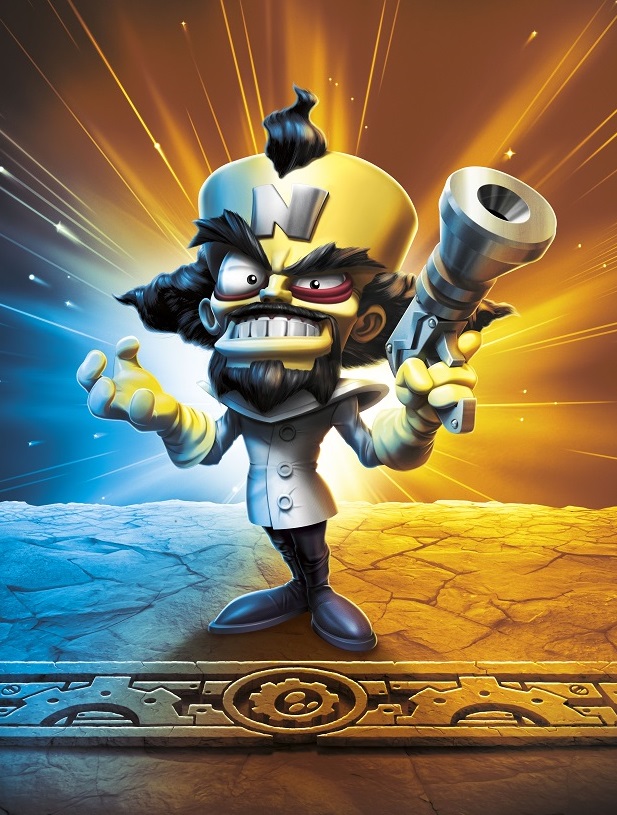





 : The respective arrow describes what way to tilt the control stick. For example, ↓
: The respective arrow describes what way to tilt the control stick. For example, ↓








